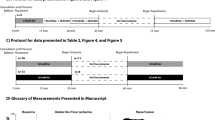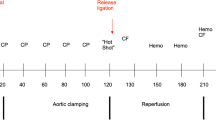Summary
The effects of Na+ and Ca2+ concentrations in the reperfusate on post-ischemic myocardial recovery were examined. Also, the myocardial protective effects of amiloride, an inhibitor of the Na+/Ca2+ and Na+/H+ exchange systems, added to cardioplegic solutions were assessed, using an isolated working rat heart perfusion system. Global myocardial ischemia was induced by 30-min normothermic cardioplegic arrest, using St. Thomas’ solution. The concentration of Na+ in the reperfusate varied, stepwise, from 75 to 145 mM/l, and that of Ca2+, from 0.1 to 2.5 mM/l. In this study post-ischemic functional recovery was best at 110 mM/l Na+ and 1.2–1.8 mM/l Ca2+ in the reperfusate. A significantly greater postischemic functional recovery and a lower creatine kinase release were observed when amiloride was added to the cardioplegic solution. Ca2+ overload via Na+/Ca2+ and Na+/H+ exchange systems would, thus, appear to be due, at least in part, to post-ischemic reperfusion injury.
Similar content being viewed by others
References
Nayler WG (1981) The role of calcium in the ischemic myocardium. Am J Pathol 102:262–270
Nayler WG, Poole-Wilson PA, Williams A (1979) Hypoxia and calcium. J Mol Cell Cardiol 11:683–706
Nayler WG, Panagiotopoulos S, Elz JS, Daly MJ (1988) Calcium-mediated damage during post-ischemic reperfusion. J Mol Cell Cardiol 20:41–54
Katz AM, Reuter H (1979) Cellular calcium and cardiac cell death. Am J Cardiol 44:188–190
Nayler WG, Sturrock WJ, Panagiotopoulos S (1985) Calcium and myocardial ischemia. Control and manipulation of calcium movement. In: Parratt JR (ed) Raven, New York, pp 303–324
Goto N, Kinoshita K (1981) Ca2+, its protective effects on ischemic myocardium (in Japanese). Biomed Ther 6:211–216
Regan TJ, Broisman L, Haider B, Eaddy C, Oldewurtel HA (1980) Dissociation of myocardial sodium and potassium alteration in mild versus severe ischemia. Am J Physiol 238:575–580
Bersohn MM, Philipson KD, Fukushima JY (1982) Sodium-calcium exchange and sarcolemmal enzymes in ischemic rabbit hearts. Am J Physiol 242:288–295
Renlund DG, Gerstenblith G, Labatta EG, Jacobus WE, Kallman CH, Weisfeldt ML (1984) Perfused sodium during ischemia modifies post-ischemic functional and metabolic recovery in the rabbit heart. J Mol Cell Cardiol 16:795–801
Crake T, Poole-Wilson PA (1990) Calcium exchange in rabbit myocardium during and after hypoxia: Role of sodium-calcium exchange. J Mol Cell Cardiol 22: 1051–1064
Tani M, Neely JR. Na+ accumulation increases Ca2+ overload and impairs function in anoxic rat heart. J Mol Cell Cardiol 22:57–72
Luzdunski M, Frelin C, Vigne P (1985) The sodium hydrogen exchange system in cardiac cells: Its biochemical and pharmacological properties and its role in regulating internal concentrations of sodium and internal pH. J Mol Cell Cardiol 17:1029–1042
Kinoshita K, Koe M, Matsuzaki H, Masuda M, Aso T, Mayumi H, Kawauchi Y, Tokunaga K, Ueno Y (1990) Ischemia reperfusion injury and divalent cations (in Japanese). J Jpn Assoc Thorac Surg 38:802–806
Grinwald PM (1982) Calcium uptake during post-ischemic reperfusion in the isolated rat heart. Influence of extracellular sodium. J Mol Cell Cardiol 14:359–365
Grinwald PM, Brosnahan C (1987) Sodium imbalance as a cause of calcium overload in post-hypoxic reoxygenation injury. J Mol Cell Cardiol 19:487–495
Reeves JP, Sutko JL (1983) Competitive interactions of sodium and calcium with the sodium-calcium exchange system of cardiac sarcolemmal vesicles. J Biol Chem 258:3178–3182
Neely JR, Rovetto MJ, Whitmer JT, Morgan HE (1973) Effect of ischemia on function and metabolism of the isolated working rat heart. Am J Physiol 225:651–658
Kirklin JW, Conti VR, Blackstone EH (1979) Prevention of myocardial damage during cardiac operations. New Engl J Med 301:135–141
Zimmerman ANE, Daems W, Hulsmann WC, Snijder J, Wisse E, Durrer D (1967) Morphological changes of heart muscle caused by successive perfusion with calcium-free and calcium-containing solutions (calcium paradox). Cardiovasc Res 1:201–209
Yamamoto F, Tanaka K, Takahashi R, Yoshida S, Yamamoto H, Ichikawa H, Shibata T, Kosakai Y, Kawazoe K, Yagihara T, Fujita T (1990) Mechanisms and prevention of post-ischemic reperfusion injury of the myocardium: Experimantal and clinical study (in Japanese). J Jpn Assoc Thorac Surg 38:807–811
Follette DM, Fey KH, Livesay JJ, Nelson RL, Maloney JV, Buckberg GD (1976) Citrate reperfusion of ischemic heart in cardiopulmonary bypass. Surg Forum 27: 244–246
Follette DM, Fey KH, Buckberg GD, Helly JJ, Steed DL, Foglia RP, Malovey JV (1981) Reducing postischemic damage by temporary modification of reperfusate calcium, potassium, pH, and osmolarity. J Thorac Cardiovasc Surg 82:221–238
Shine KI, Douglas AM (1983) Low calcium reperfusion of ischemic myocardium. J Mol Cell Cardiol 15:251–260
Irisawa T, Aoyama K, Hoshinaga S, Nishimura K, Imai T, Washio M, Wakabayashi A, Rietfors K (1983) The effects of calcium concentration of reperfusates on the recovery of rabbit hearts following anoxic cardioplegia (in Japanese). J Jpn Assoc Thorac Surg 31:1498–1504
Hamasaki N (1987) Effects of hypothermia on calcium-related reperfusion injury in the isolated rat heart (in Japanese). J Yonago Med Assoc 38:259–267
Menasche P, Grousset C, Boccard G, Piwnica A (1984) Protective effect of an asanguineous reperfusion solution on myocardial performance following cardioplegic arrest. Ann Thorac Surg 37:222–228
Ohashi T, Yamamoto F, Yamamoto H, Ichikawa H, Komai H, Shibata T, Nakajima N, Kawashima Y (1991) The effects of calcium concentration of reperfusion solution upon myocardial protection (in Japanese). J Jpn Assoc Thorac Surg 39:1971–1975
Ferrari R, Albertini A, Curello S, Ceconi C, Lisa FP, Raddius R, Visioli O (1986) Myocardial recovery during post-ischemic reperfusion: Effects of nifedipline, calcium, and magnesium. J Mol Cell Cardiol 18:487–498
Ashida Y (1990) A study on reciprocal dependency of calcium and magnesium concentrations in the reperfusate for post-ischemic myocardial function (in Japanese). J Yonago Med Assoc 41:23–33
Ohashi T, Yamamoto F, Yamamoto H, Ichikawa H, Shibata T, Shimada Y, Nakajima N, Kawashima Y (1991) The effects of magnesium concentration in the reperfusion solution upon myocadial protection (in Japanese). J Jpn Assoc Thorac Surg 39:2134–2139
Tani M, Neely JR (1990) Effects of modification of perfusate electrolyte composition on reperfusion injury in rat heart (in Japanese). J Keio Med Soc 67:611–618
Tani M, Neely JR (1990) Mechanisms of reduced reperfusion injury by low Ca2+ and/or high K+. Am J Physiol 258:1025–1031
Ohashi T, Yamamoto F, Yamamoto H, Ichikawa H, Shibata T, Shimada Y, Ishikawa T, Kagizaki K, Kumada Y, Kawashima Y (1992) The effects of potassium concentration in the reperfusion solution upon myocardial protection (in Japanese). J Jpn Assoc Thorac Surg 40:11, 1998–2004
Trosper TL, Philipson KD (1983) Effect of divalent and trivalent cations on Na+−Ca2+ exchange in cardiac sarcolemmal vesicles. Biochem Biophys Acta 731:63–68
Ying-Xin Zhuang, Cragoe EJ Jr, Shaikewitz T, Glaser L, Cassel D (1984) Characterization of potent Na+/H+ exchange inhibitors from the amiloride series in A43 cells. Biochemistry 23:4481–4488
Reynolds EE, Brum JM, Cragoe EJ Jr, Ferrario CM (1988) Effect of Na+/H+ exchange inhibitors on agonist-induced contraction of rat aorta. J Pharm Exp Ther 247:1146–1151
Rabkin SW (1989) Comparison of the effect of amiloride and its analogue dichlorobenzamil on cardiac chronotropic responses to ouabain in myocardial cell aggregates in culture. Pharmacology 39:230–239
Wettwer E, Himmel H, Ravens U (1992) Amiloride derivatives as blockers of Na+/Ca2+ exchange: Effects on mechanical and electrical function of guinea pig myocardium. Pharmacol Toxicol 71:95–102
Scholz W, Abus U, Linz W, Marforana P, Lang HJ, Scholkens BA (1992) Effects of Na+/H+ exchange inhibitors in cardiac ischemia. J Mol Cell Cardiol 24:731–740
Karmazyn M, Ray M, Haist JV (1983) comparative effects of Na+/H+ exchange inhibitors against cardiac injury produced by ischemia/reperfusion, hypoxia/reoxygenation, and the calcium paradox. J Cardiovasc Pharm 21:172–178
Author information
Authors and Affiliations
Rights and permissions
About this article
Cite this article
Yamada, T., Takagi, M., Kugimiya, T. et al. Myocardial recovery during post-ischemic reperfusion: Optimal concentrations of Na+ and Ca2+ in the reperfusate and protective effects of amiloride added to cardioplegic solution. Heart Vessels 10, 310–317 (1995). https://doi.org/10.1007/BF02911389
Received:
Revised:
Accepted:
Issue Date:
DOI: https://doi.org/10.1007/BF02911389




